
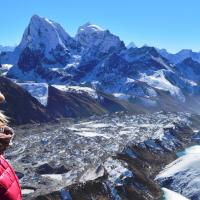

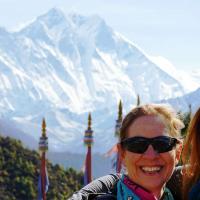
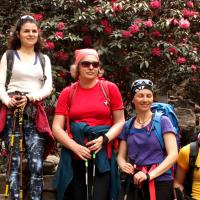
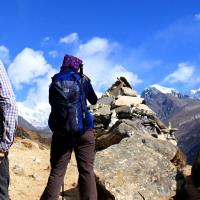
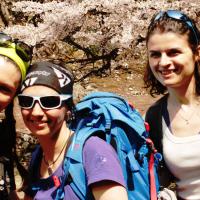
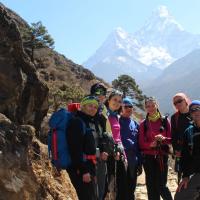
Embark on the Everest Base Camp and Gokyo Lakes Trek, a journey that not only fulfills the lifelong dream of reaching Everest Base Camp but also takes you beyond to the tranquil Gokyo Valley. This trek offers a complete experience of the Nepal Himalaya, blending adventure with breathtaking natural beauty.
The challenge of crossing the Cho La Pass (5,420m/17,782ft) will test your stamina, while the serene Gokyo Lakes provide a meditative retreat. Standing atop Gokyo Ri (5,357m/17,575ft), you'll witness a spectacular 360-degree panorama of the world's highest peaks, including Everest, Lhotse, Makalu, and Cho Oyu—views that are beyond words.
Your adventure begins in Kathmandu, where you'll spend two nights exploring the vibrant city and its UNESCO World Heritage sites, allowing time to acclimate and prepare for the trek. From there, a scenic flight to Lukla marks the start of your journey through the Everest region.
Trekking through the Dudh Koshi Valley, you'll pass through the renowned villages of Phakding, Monjo, Namche Bazaar, Tengboche, Dingboche, Lobuche, and Gorakshep. Along the way, you'll immerse yourself in the local Sherpa culture, experience the region's rich Buddhist traditions, and enjoy the hospitality of locally run teahouses.
As you follow the classic trail to Everest Base Camp, you'll be surrounded by towering peaks, pristine valleys, and a rich diversity of flora and fauna. After reaching Base Camp, you'll continue to the stunning Gokyo Valley, where you'll hike up to Gokyo Ri for an unforgettable view of four 8,000-meter giants and the vast Ngozumpa Glacier.
This trek is ideal for adventure seekers with previous trekking experience who are ready to take on the challenges of high-altitude hiking. If you're new to trekking but physically fit, we recommend our Everest Base Camp Trek, which is suitable for beginners. For more seasoned trekkers looking for an even greater challenge, the Everest Three Passes Circuit Trek offers an exhilarating experience in the Everest region. Alternatively, you can choose to focus on the Gokyo Lakes and Gokyo Ri Trek. Explore our other trekking options in Nepal for a variety of unforgettable Himalayan adventures.
Welcome to Kathmandu! As you land at Kathmandu airport (TIA), reclaim your luggage, and finish your customs formalities (visa and more). At the airport terminal, you will find our representative with the company signboard accompanying your name, waiting eagerly to greet you.
You will then be transferred to your hotel to rest and recover from jet lag. If you have extra time, you can visit the Thamel market for any trekking gear you need for your 19 days trek.
Note: Depending on your choice, we can have a pre-trip meeting at our office or your hotel. If you arrive after 4 pm, the pre-trip meeting and the trip briefing will be done tomorrow (Day 02) after sightseeing activities.
More on pre-trip meeting: The meeting will include getting to know your trek guide and other trekking group members. Please take this opportunity to ask questions regarding the Everest Base Camp and Gokyo Lakes Trek or, as a whole, your questions regarding Trekking in Nepal. We will also provide you a down jacket, an Everest Base Camp trekking map, a T-shirt, and a Duffel Bag to pack your things. At the meeting, we will also require your passport, two passport-size photos, and a readable copy of your travel insurance policy. During this meeting, please clear the due balance, if any, and sign the legally binding trip form and the non-liability disclaimer.
After breakfast, we shall start a guided tour of these four medieval and spiritual sites in Kathmandu, also listed as UNESCO World Heritage Sites:
Durbar Square: The Royal palace compound of the Malla kings boasts a rich history with palaces, temples, and courtyards dating back to the 12th to 18th centuries. The area is highlighted by a 17th-century stone inscription set into the wall of the palace, Taleju temple (tallest of all structures built in 1549 A.D.), Jagannath temple (known for fascinating erotic figures carved in the wooden struts and eaves), Kal Bhairav (large stone idol representing the terrorizing aspects of Shiva), Statue of King Pratap Malla in praying gesture to Digu Taleju the royal family deity right across, Kumari Ghar (17th century Kumari temple), Kasthamandap (built from the timber of a single tree). The entire Palace Complex is also known as Hanuman Dhoka, named after a monkey god called Hanuman. A red stone statue of Hanuman stands by the palace entrance, protecting Durbar Square.
Pashupatinath: It is one of the world’s most significant Hindu temples of Lord Shiva on the bank of the Bagmati River. It is a square two-tiered pagoda temple built on a single-tier plinth that is famous worldwide. Although entrance into the temple complex is only allowed to Hindus, you can see the temple and the activities from the eastern bank of the Bagmati River, which is also one of the important cremation sites for Hindus in Nepal.
Bouddhanath: It is one of the largest Stupas in the world with a unique octagonal Mandala design with hundreds of prayer wheels, and 108 images of the Buddha set into the niches around the huge structure. It’s nicknamed “Little Tibet” due to over 50 Tibetan monasteries. You can join the locals to circumambulate the Stupa, explore handicrafts in the shops, or enjoy the atmosphere from the rooftop restaurant.
Swoyambhunath: Swoyambhunath Stupa is a 2000-year-old Buddhist shrine popularly known as Monkey Temple due to the profusion of monkeys in the shrine area. Its main temple is capped by a pinnacle of copper gilt and is painted on four sides with the all-seeing eyes of Lord Buddha.
Please pack your belongings in the provided duffel bag before the day ends. Keep your luggage weight to 10 kg and backpack weight to 5 kg. You can carry extra items if needed, but prioritize essentials. Remember to be kind to the porters, who will not deny having that extra 1-2 kg load.
Wake up at dawn and be ready for the adventure as we escort you to the domestic terminal of Kathmandu airport for an early morning flight. After an adventurous flight above the beautiful mountains, we arrive at the Tenzing-Hillary airport at Lukla, an entry town from where your trek begins.
We will meet our additional crew members in Lukla and do some packing and arrangements. Then our trek officially begins through the prosperous village of Lukla, from where we will descend to Chaurikharka and head up the Dudhkoshi valley until we reach Phakding.
As we land at an altitude of almost 3000m today, we will only have a short walk to assist in acclimatization. However, if you are interested in more activities, you can take a side trip to a nearby monastery.
The primary gateway to the Everest Base Camp Trek is via a flight to Lukla (2840m), which lands at one of the world's most extreme airports: Tenzing-Hillary Airport. Positioned on a narrow plateau above a steep cliff with a short and narrow runway, the flight itself is as thrilling as it is challenging. Weather conditions here are notoriously unpredictable, with visibility shifting rapidly, which adds a layer of excitement to the journey.
Ramechhap AirportDuring the busy trekking seasons in spring (March, April) and autumn (October, November), Kathmandu Airport faces significant congestion, leading most flights to Lukla to operate from Manthali Airport in Ramechhap, approximately a 4-5 hour drive from Kathmandu. To avoid this drive, you can opt for a helicopter flight from Kathmandu, though this is an additional expense.
WeatherFlights to Lukla are dependent on clear weather and stable conditions. Delays or cancellations are common due to sudden shifts in weather, which may extend your trekking plans by a few days. We recommend adding buffer days to your itinerary to mitigate any disruptions to your return travel plans.
In the event of prolonged delays, a helicopter transfer to Lukla is an alternative, although this incurs additional costs and is not included in the standard trek package. While helicopters can operate in some conditions that planes cannot, extreme weather can ground them as well. In such cases, we will endeavor to arrange a helicopter charter, subject to availability and weather permitting. Please note, helicopter availability is limited and may lead to delays.
We ask for your flexibility and understanding in these situations. If weather conditions prevent flights for an extended period, an alternative is to drive to Tham Danda—a challenging 20-hour journey—and begin the trek from there. This route is prone to difficulties, especially in adverse weather, requiring extra days and considerable patience.
Should conditions make the Everest Base Camp Trek unfeasible, we can redirect to other treks such as Annapurna Base Camp or Langtang Gosainkunda. While these treks do not lead to Everest Base Camp, they offer stunning views and rewarding experiences.
Your cooperation and flexibility are crucial in navigating these complexities, ensuring a memorable and enjoyable trekking experience regardless of the route.
Today’s trek is exciting due to the first glimpse of Everest with clear weather, the crossing and re-crossings of Dudh Koshi River, and the magnificent view of Mt. Thamserku (6,608m/21,675ft) from the Benkar village. After walking for a bit, we will get our trekking permits checked at the entrance of Sagarmatha national park at Monjo.
We tumble down, and a gradual walk brings us to Jorsale, the last village until Namche Bazaar. The trek further is relatively more straightforward until we cross five bridges today, which ends as we reach Hillary Suspension Bridge. From here, the walk will be mostly uphill towards Namche Bazaar, rewarding with frequent glimpses of Kwangde Peak, Kusum Peak, Kangaru Peak, mt. Everest, Lhotse, Tawache, and many other magnificent mountains.
We will take a break at the Chautala (rest spot with a tree) to admire the view. Then, finally, we reach the colorful village of Namche Bazaar, the main Sherpa town and trading station in the Khumbu situated spectacularly in a CWM on the mountainside.
To have a successful trek, staying hydrated, taking breaks while walking, and acclimating to the altitude is essential.
Today we will stay at Namche Bazaar, an ideal altitude to spend an acclimatization day before heading towards a higher elevation. If we trek a few hours uphill during the day will help us properly acclimate. We can spend the day exploring Namche Bazaar or take an enjoyable side trip up to Khumjung, Syangboche airstrip, and Everest View Hotel, a Japanese build deluxe hotel offering you great views of Mt. Everest, Ama Dablam, Nuptse, Lhotse, and others.
If you are looking for more options, there is a pretty village-Khumjung surrounded by the snowy peaks of Kongde and Thamserku and the sacred mountain Khumbila. Here, we can find the “Schoolhouse In the Clouds” school built by Sir Edmund Hillary, and the famed Khunde Hospital is also nearby. We can enjoy the day by visiting the hospital, school, and monastery here. In addition, you can take a hike to Thame or Khunde if you have time and interest.
If we stay here on Friday and Saturday, we must remember to participate in the colorful market in Namche Bazar. Along with all these options, we could also visit the Visitor Center near the Sagarmatha National Park’s headquarters. There, we can observe various things allied to the first Everest ascenders and Sherpa culture and learn about the diverse flora and fauna of the Sagarmatha National Park.
After ascending out of Namche Bazaar, the first 2 hours of walking are relaxed, traversing the left-hand side of the valley, high above the valley base. From every bend, we can see the outstanding view of the chain of mountains and snowcapped peaks. So, we must take a break as we come across beautiful mountain views to capture them in our cameras.
As the trail passes through forests of birch and silver fir trees, you may spot wildlife, including musk deer, a herd of Himalayan Thar, and colorful pheasants. The path then descends steeply downhill towards the river to Phunki Tenga, where we will have lunch.
After crossing the suspension bridge, we come across a few prayer wheels running through hydropower. Throughout the trek today, we walk through the forest and can watch out for animals too. Finally, after two hours uphill walk, we reach the beautiful monastery town of Tengboche, perched on a ridge up the river valley. After a brief rest, you can visit the monastery and attend a prayer session too.
Today we wake up early to witness cultural Tibetan Buddhism rituals at the ancient Tengboche monastery. After breakfast, we start our trek today with a gradual downhill walk through the rhododendron forest and the village of Debuche until we cross the Imja Khola.
Then after crossing the river, we will be hiking uphill towards Pangboche, where we will have lunch enjoying the majestic close view of the beautiful mountain The Ama Dablam (literally mother's necklace). After that, we further walk toward Dingboche.
As we cross the tree line, the trail starts to be more alpine, i.e., rocky, windy, and dusty, with only small shrubs. Our body may also begin showing symptoms of the effect of altitude, like headaches, nausea, and loss of appetite. We must eat sufficient carbs and drink at least 3 liters of water to avoid weakness caused by higher altitudes. Overnight at a teahouse in Dingboche.
Today is the second acclimatization day. After enjoying breakfast while glancing at Ama Dablam, we hike to a ridge called Nangkartshang Peak which is behind Dingboche Village. You can stroll halfway or even to the top to aid acclimatization. Remember that the higher you go, the better the views are.
On the way to Nangkartshang Peak, you see peaks like Lobuche East Peak (6119m), Lobuche West (6145m), Taboche Peak (6367m), Thamserku (6608m), Kangtega (6685m) and Ama Dablam (6856m). If you hike to the top, you can see Pheriche Valley too.
You can also opt to hike to Chhukung Ri instead of Nangkartshang. However, it would be easier for the whole group to decide. Hike to Chhukung Ri will be a longer hike with views of 8000m peaks Mount Lhotse, Mount Makalu, and Mount Cho Yu.
Our target distance today is comparatively short, but it will take us a long time as the presence of thin air makes walking strenuous. Therefore, taking it slow and drinking plenty of water is wise to prevent altitude sickness. Also, pack a windproof jacket in your daypack before you hand over your luggage to porters.
We will walk across the ravine, which is the end of Khumbu Glacier. Although walking is strenuous at this altitude, the beautiful snow-capped peaks with the background of a lively sky will motivate us to move ahead and discover more of the beauties. There will be a gradual incline up to the Thukla pass in the first three hours.
As soon as we reach the top of the pass, we enter the Everest Memorial, where we pay our respect to the brave souls who ended their lives in love for Everest. Then, we will rest and explore before walking one more hour to Lobuche.
We start on a gradual trail first, and after an hour, the path becomes steep, with numerous boulders to pass. While it isn’t a strenuous climb, the altitude will affect us, so we will walk slowly.
We will reach Gorekshep at lunchtime, check in to our teahouse, have lunch, and start the afternoon hike to Everest Base Camp. The trail is beautiful, with giant mountains surrounding us. Still, it has plenty of rocky sections and loose stones as we walk through Khumbu Glacier’s moraine, so we must be careful. Arriving at Everest base camp will be dreamlike as we look around us.
You can see the Khumbu Icefall in the distance, one of the most infamous critical sections leading up to Everest. We feel absolutely overwhelmed standing at the foot of the highest mountain in the world. But getting too excited and overexerting is not suitable for health at this altitude. So again, we will have a two-hour hike down to Gorekshep for an overnight stay.
We will wake up approximately two hours before the day begins and hike to Kalapatthar to witness the sunrise from an altitude of 5545m, along with a magnificent view of snow-capped mountains. It is a steep trail for 1.5 hours to the top of Kalapatthar, where the sceneries cannot get justice with simple words.
We can see a 360-degree panorama of the Everest range right there, with Mount Everest directly in front of us and Mt. Pumori and Nuptse to our left. For a while, we will feel at the top of the world. Then, we walk back to Gorekshep, which takes about an hour, have breakfast, and trek down to Dzongla.
While we trek down the trail, we get to see amazing views of Lobuche Peak, Chola Tsho Lake, Arakam Tse (6,423 m), Cholatse (6,335 m), and Taboche (6,367 m). Finally, we will stay overnight in the small village of Dzongla, where we will continue our journey to Gokyo tomorrow.
Some people break this day into two, making an overnight at Thaknak. Still, it's wise to trek to Gokyo directly from Dzongla. You have to make an early start for the Chol La Pass crossing to avoid sunshine which can melt the ice of the trail, making it slippery, and wind which risks stone falls.
If you start early and are a good walker, you will reach Thaknak at lunchtime (by noon, if not at least by 2 pm). After lunch at Thanknak, it's just two hours walk to Gokyo. It is worth it because the accommodation and atmosphere are better in Gokyo than in Thanknak.
Today's trail is more challenging than the classic Everest Base Camp Trail. As we reach the top of Chola, we will be rewarded with views of Ama Dablam and Cholatse before descending from Chola.
After a brief rest at Thanknak, we will cross the Ngozumpa Glacier. Finally, after about two to three hours, we reach Gokyo, set at the bank of the third lake of Gokyo Valley.
One of the major highlights of the Everest base camp and Gokyo Lakes trek is hiking over Gokyo Ri. We start our day early in expectation of incredible morning views. However, a challenging yet gratifying walk to the top of Gokyo Ri can take more than a couple of hours.
The summit of Gokyo Ri is famous for providing the best panoramas in the Himalayan range with broad views of 8000m mountains such as Mount Everest (8,850m), Makalu (8,485m), Lhotse (8,516m), Cho Oyu (8,201m), Lobuche, along with other exquisite Mahalangur Himalayan range, largest Ngozumba glacier, and the five consecutive lakes stretch along the Gokyo valley.
After savoring the incredible Himalayan vista, we return to Gokyo village. People with energy can also do an optional hike to the fourth or fifth Gokyo Lakes.
Since you will be losing altitude as you walk, you will find the hike easier today. The scenic track descends past the second and first Gokyo Lake and along the Dudh Koshi River. Behind you will see incredible views of both Cholatse and Cho Oyu peaks.
The trail then climbs again, offering views of Amadablam, Kantega, and Thamserku. We walk past the villages of Machermo and Luza villages and reach Dole early afternoon. Accommodation: Local teahouse, Included Meals: B, L, D
The day begins with a steep downhill toward Phortse Tenga. It takes approximately ONE and a half hours to reach Phortse Tenga from Dole. Then, the trail ascends steeply from Phortse Tenga up to the village of Mongla. Mongla is is a settlement on a hilltop with awesome mountain views. We walk through the greenery of rhododendron forests, waterfall, and the village of Kyangjuma before reaching the vibrant town of Namche Bazaar.
Today we complete the Everest Base Camp and Gokyo loop by trekking back to Lukla. Although you are losing elevation, we will feel like a long day because our legs are weary and the downhill will feel stressed on knees. We trek back the same trail we took to our way up.
We took two days to reach Namche Bazaar from Lukla when we walked up, but we have to walk this length in one day. We feel sad that we are leaving the Everest Himalayas back there, the Sagarmatha National Park, the lovely hospitable villages and environment, the lovely trekking crew.
Again there is reason to be happy too that you have your mission successful. We celebrate the farewell with the porter's crew. The porters will not be flying back to Kathmandu tomorrow, so you are suggested to tip them today and show your gratitude to them. Porters are the pillars of the trade of trekking in Nepal. They deserve the appreciation for their hard work.
With a great sense of mission being successful, we fly back to Kathmandu. Again try taking the left pane of the plane and savor the Himalayan beauties from the plan as much as you can. Upon arrival at Kathmandu airport, we will be transferred to a hotel in Kathmandu.
Take good time to take a satisfying longer hot shower. Rest of the day you can hang around the market and collect souvenirs for your kin or just rest at your hotel. Icicles Adventure would offer you a dinner tonight in a cultural Nepali restaurant.
We would be pleased if you could give your honest feedback regarding the services provided on a trek to the official representative of Icicles Adventure.
It's time to say goodbye. We are proud and happy that you completed one of the famous challenging adventures in Nepal, the Everest base camp and Gokyo Lakes Trek. Three hours before your flight time, you will be dropped at the airport. Hoping we made you satisfied and happy with our services, we look forward to your comeback for your next trekking in Nepal. Included Meals: B
Note: You are suggested to come with an extra day (or 2) buffer days for all treks that need Kathmandu/Lukla/Kathmandu flights. Since Kathmandu/Lukla/Kathmandu flight is affected extremely by weather, sometimes even in months those are said to have good weather.
Delays are quite common, and cancellation also happens often. Extra days should always be scheduled at the end of the trip; this gives you flexibility with your trekking itinerary for any weather delays. More about Kathmandu/Lukla/Kathmandu flights
If the flights happened as planned, we would help book a hotel in Kathmandu for you. Then, you can further do sightseeing activities in historical and cultural sites near Kathmandu valley. Or, if you have at least 3 buffer days, you can do a visit to the nice natural city of Pokhara or do a jungle safari tour in Chitwan National Park.
Yes, overnight at EBC can be arranged! Staying overnight at base camp is recommended during the spring season in April/May as you get to see and meet Everest climbers (mountaineers). Plus, the base camp is colorful during this time.
You must get a Pasang Lhamu Rural Municipality permit and Sagarmatha National Park Entry Permit. In addition, if you travel by road from Kathmandu to Jiri, an additional Gaurishankar Conservation Area Project permit is also required. However, you do not have to worry; your trekking agency will manage your permits.
We suggest you choose a private EBC trip enjoying your journey without any pressure. We also offer private trips for your private group and solo trek. In both cases, your journey will be flexible and fun to your liking.
Proper gear and equipment are necessary to make our trek less strenuous. If you own a sleeping bag, sleeping mat (airbag), trekking boots, and down jacket, we recommend using the same during the trek. But don’t worry if you don’t have them! Our company will arrange it if you.
For the EBC trek, previous trekking experience is not mandatory. However, you will need experience if you want to add Gokyo Valley to your EBC itinerary, even if you are physically fit to walk along the trails of high mountains.
Almost all your costs during the trek are included in the EBC Trek of Icicles Adventure package. However, for extra costs not included in our package, like purifying water, charging batteries, and donating, we recommend you carry a minimum of 10 USD daily.
In such cases, you will be boarded on the next flight. Therefore, you will spend an extra night at Lukla/Kathmandu.
We recommend you allocate a couple extra days for the Everest base camp trek to avoid missing your international flight back home.
We can drive from Kathmandu to Jiri (9 hrs) and trek for a week to reach Lukla. We can also take a private jeep from Kathmandu to Salleri (15 hrs) and walk two days from Salleri to Lukla.
Yes, indeed there are three major things you need to keep in mind:
These are standard group departures for Everest Base Camp and Gokyo Lakes Trek trip. We understand these departures may not suit your schedules, if so, please feel free to ask a customized departure date that suits you. Also, if you are looking for a different customized itinerary, please ask our local travel specialist for a new personalized, customized program as per your interests and requirements.
| Trip Start Date | Trip End Date | Seat Left | Price (USD) | Status | |
|---|---|---|---|---|---|
|
Saturday
29-Mar, 2025 |
Tuesday
15-Apr, 2025 |
- | USD 1690 | Book Now | |
|
Thursday
03-Apr, 2025 |
Sunday
20-Apr, 2025 |
- | USD 1690 | Book Now | |
|
Saturday
05-Apr, 2025 |
Tuesday
22-Apr, 2025 |
- | USD 1690 | Book Now | |
|
Thursday
10-Apr, 2025 |
Sunday
27-Apr, 2025 |
- | USD 1690 | Book Now | |
|
Thursday
17-Apr, 2025 |
Sunday
04-May, 2025 |
- | USD 1690 | Book Now | |
|
Thursday
24-Apr, 2025 |
Sunday
11-May, 2025 |
- | USD 1690 | Book Now | |
|
Thursday
01-May, 2025 |
Sunday
18-May, 2025 |
- | USD 1690 | Book Now | |
|
Monday
05-May, 2025 |
Thursday
22-May, 2025 |
- | USD 1690 | Book Now | |
|
Friday
09-May, 2025 |
Monday
26-May, 2025 |
- | USD 1690 | Book Now | |
|
Friday
23-May, 2025 |
Monday
09-Jun, 2025 |
- | USD 1690 | Book Now | |
|
Thursday
05-Jun, 2025 |
Sunday
22-Jun, 2025 |
- | USD 1690 | Book Now | |
|
Friday
06-Jun, 2025 |
Monday
23-Jun, 2025 |
- | USD 1690 | Book Now | |
|
Thursday
11-Sep, 2025 |
Sunday
28-Sep, 2025 |
- | USD 1690 | Book Now | |
|
Friday
19-Sep, 2025 |
Monday
06-Oct, 2025 |
- | USD 1690 | Book Now | |
|
Thursday
25-Sep, 2025 |
Sunday
12-Oct, 2025 |
- | USD 1690 | Book Now | |
|
Thursday
02-Oct, 2025 |
Sunday
19-Oct, 2025 |
- | USD 1690 | Book Now | |
|
Thursday
09-Oct, 2025 |
Sunday
26-Oct, 2025 |
- | USD 1690 | Book Now | |
|
Thursday
16-Oct, 2025 |
Sunday
02-Nov, 2025 |
- | USD 1690 | Book Now | |
|
Friday
24-Oct, 2025 |
Monday
10-Nov, 2025 |
- | USD 1690 | Book Now | |
|
Saturday
01-Nov, 2025 |
Tuesday
18-Nov, 2025 |
- | USD 1690 | Book Now | |
|
Saturday
08-Nov, 2025 |
Tuesday
25-Nov, 2025 |
- | USD 1690 | Book Now | |
|
Saturday
15-Nov, 2025 |
Tuesday
02-Dec, 2025 |
- | USD 1690 | Book Now | |
|
Thursday
05-Mar, 2026 |
Sunday
22-Mar, 2026 |
- | USD 1690 | Book Now |
Registered with: Company Registration Office, Government of Nepal
Licensed by: Nepal Tourism Board & Department of Tourism
Proud Member of Trekking Agency's Association of Nepal
General Member of Nepal Mountaineering Association
Life Member of Kathmandu Environmental Education Project